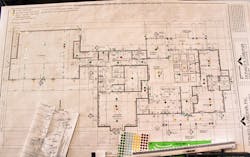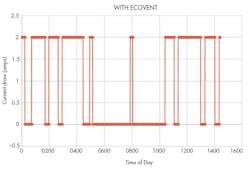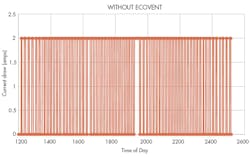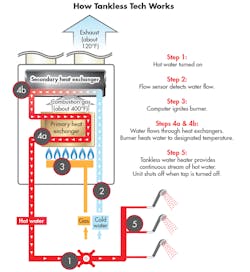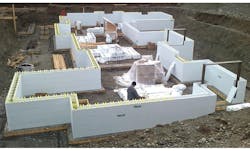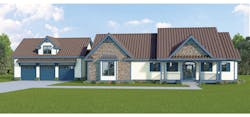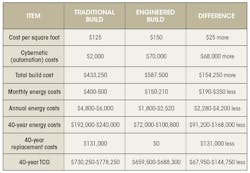Download this article as a .PDF
If architects and development firms treated houses as engineering projects, perhaps they would cost less, last longer, use less energy, and keep the inhabitants more comfortable. For example, let’s say the goal or project was to build single-family residential house.
First, the building team would meet to set some goals—performance specs the finished structure should meet. Some “simple” ones could be:
- Maintenance-free, meaning no major repairs or replacements for 40 years.
- Energy-miserly—not totally off the grid, just using significantly less than normal.
- A networked, modern house can be more than just an automated remote-controllable house. It can be self-controlled and adaptive with a considerable amount of awareness and self-memory.
So, much like at the start of any design project, there’s framework…albeit one that needs additional definition and refinement.
Treating the House as a System
Is it possible to design a completely maintenance-free system? The specifics of the first design goal, putting a 40-year limit on major repairs, help make this a more realistic challenge. And if it is not fully possible, how close can we come to eliminating failures that result in needing repairs or replacements?
That’s a more familiar challenge for many designers, especially if the house is treated as a system comprised of major elements and subsystems. So the design team can now:
- Identify potential points of failure. For example, wood warps, plumbing connections leak, and driveways crack.
- Analyze contributors to failure. High or low temperatures and humidity accelerate aging, as do strong winds and continuing UV exposure.
- Investigate alternatives. Technology is always providing new answers. For example, engineered lumber maintains strength and rigidity longer than traditional dimensional lumber, and “home run” configurations of PEX pipe eliminate many plumbing leak sources. In a home-run set up, each water line runs untapped and uninterrupted all the way from a dedicated connection on a water manifold block to a single home-point, such as a faucet.
- Optimize. Variable-speed fans and compressors enjoy much longer mean times between failures (MTBF) than more traditional HVAC components. Similarly, extra inches of concrete increase the MTBF for driveways.
- Establish open- and closed-loop monitoring. For example, plantings, which can be expensive, may fail if over- or under-irrigated. But local weather monitoring and macro weather forecasts through online software application programming interfaces (API) calls, which are largely open-loop readings, can work with (closed loop) direct ground moisture monitoring to closely control watering.
- Design controls to be adaptive. Adaptive lighting controls, for example, can respond to occupancy, time of day, ambient light levels, and occupant overrides, all of which are now available. But they should also respond to whether a bedroom occupant is awake or asleep and to whether or not danger or hazards are present.
Avoiding Maintenance
LED lighting has reduced energy use and heat generation while extending operational life expectancy compared to the bulbs and fixtures it replaces. Using LED bulbs means not changing or otherwise maintaining them for years. They’re a good example of tactical material/subsystem choices with strategic design benefits. There are many more.
Engineered lumber can replace traditional dimensional lumber in framing and building a house, plus it lasts longer, performs better, and provides significant benefits. It offers more strength and greater dimensional stability, among other things. This means floors and ceilings are much less likely to sag, even decades later. And engineered panels that sandwich a solid inner layer of enhanced insulating foam are the basis of structural-insulated-panel (SIP) walls that offer more support strength and much better insulation than traditional “stick” (stud-and-header) construction.
Some metal roofing outlast traditional shingles by several decades, offer finishes that closely resemble traditional roofing, and, more importantly, shed heat through reflective coatings. When constructed with an outward-facing foil directly on the outside roofing board and support studs that provide an insulating air gap between the foil and underside of the roofing, the attic interior benefits from a significant degree of thermal separation from exterior temperatures. At that point, the attic can air conditioned at a net energy efficiency gain for the house. This also reduces wear-and-tear on HVAC equipment, helping it avoid maintenance.
There are many other measures that lower the MTBF for HVAC systems. A system that uses a variable compressor (scroll compressors are one example) and variable-speed blower, for example, provides a smoother response to internal temperature changes and puts less stress on components. Double-wall ducts and insulated duct boots add to the stop-loss effectiveness of traditional duct insulation.
PEX piping run directly from usage points—such as sinks, showers, and spigots—to water distribution manifolds eliminates pipe junctions, the most likely in-wall point of origin for leaks. When hot and cold PEX lines are bundled inside a double-walled or otherwise-insulated duct, there is much less heat transfer/loss exchange between them enroute, so hot water comes out hotter and cold water comes out colder.
Becoming Energy-Miserly
Designers asked to reduce a system’s energy consumption often end up working to improve already-good energy efficiency in subsystems because that’s where the greatest gains can be made. But when designing a house, the greatest gains are through another familiar approach: stopping losses.
A stop-loss approach to thermal transfers in air and water can dramatically affect a house’s energy needs. Some examples:
- Thermally isolating the interior of the house from its exterior lets builders focus on constructing the structure so it reduces conductive and convective heat transfer, and helps a house maintain interior comfort longer with less energy. Components and techniques that would help here include SIP walls; an insulated concrete foundation (ICF) that thermally separates the house from the surrounding ground; thoroughly insulating the attic ceiling and using air-separated metal roofing; and thermal windows with frames that eliminate thermal bridging.
- The hot water subsystem offers many opportunities for savings. A 200-gallon tank in an air-conditioned attic can raise incoming water temperatures into the mid-70s, essentially for free, reducing the energy a heater needs to bring water to a target temperature. Master bedroom showers represent the biggest overall use of residential hot water, and a heat exchanger at the shower drain can also boost the water heater feed temperature. A condensing tankless water heater does a similar service, exposing incoming water line to the heat in its flue for another reduction in energy use.
- Flow-tuning ventilation through motorized register curtains, such as those in the EcoVent System, can monitor room temperatures and duct back-pressures, then automatically and continually adjust each vent so that no room is ever too hot or too cold—all without needing a split system. This also lets HVAC systems run longer with each use and idle longer between runs for less overall energy use and less wear-and-tear on HVAC components.
- Real-time thermal mapping can be done using Panasonic’s Grid-EYEs and Raspberry Pi 3 Model B’s in ceiling-mounted 2-gang electrical boxes, with each monitoring a 2 × 2 ft square in a room. They can detect and track warm bodies for error-free occupancy detection. This information can be sent to lighting and heating subsystems to light and heat or cool the room as needed. Comfort settings are relaxed for vacant rooms, which saves energy and wear. It also allows monitoring of background temperatures across a room’s grid so uneven readings can first engage ceiling fans to stir the air; if there’s still an anomaly, the subsystem can inform the homeowner of possible insulation or ventilation issues.
- Passive components can also contribute. For example, oversized eaves reduce exposure of walls and windows to direct solar heating by increasing the number of minutes they remain in shade.
Making it a Cybernetic House
All machines, systems, and subsystems need a controller. So every house has a controller or two: sometimes it’s the human occupants, sometimes it’s the elements, and—ever since the invention of the thermostat—there are often automatic controls.
Designing modern automation into a house through a systems design can involve thousands of sensors, more than a hundred actuators, and almost a hundred controllers, all networked into a single system. In one approach, most of the controllers are Raspberry Pi 3 Model B’s connected over 100 Mbps Ethernet. Many of these act as intelligent nodes at sensor and actuator locations. For example, 30 of them might go into ceiling boxes that map temperatures (as well as several other functions), while 36 are housed in a master control rack. Others are at various points of use.
This is a distributed, minimally hierarchical network with a “spine” which is a silo of network-attached live and historic data in a MySQL database. But it does much more than simple logging. Each node has several tasks, including analysis and evaluation in determining what it will write to the database, and each can incorporate results of queries into the database to perform its analyses. For example, five ultrasonic sensors mounted in or near the ceiling over the garage’s three spaces can use readings to detect the presence or absence of cars and open or closed status of the garage doors. All of this data would get written to the MySQL database. Queries regarding that data are part of the lighting-control logic. If a car arrives home, for instance, the system turn on garage lights and send an e-mail to other cars not yet home saying that its car and driver are home. Queries to the database provide faster and more nuanced information than status polling among several sensors or nodes.
So, the overall system becomes self-controlled, not simply remote controlled. It’s adaptive. One controller is dedicated to performing exploratory and experimental activities that, if successful, can migrate to the rest of the system. For example, the designer might not incorporate weather info into the lighting or comfort controls. Instead, the experimental node might try correlating forecast precipitation or cloud cover with ambient indoor brightness to determine if dimming the lights earlier would be better than simply greyed down natural lighting. Similarly, forecast temperature swings might make sense to use for tweaking comfort settings so there are fewer abrupt changes to HVAC demand when the temperature changes arrive. Other controllers expressly monitor the overall control system with a goal of preventing or mitigating failures.
The sensors can include those that detect and monitor thermal, ultrasonic, Lidar, passive IR, beam-break, Doppler radar, humidity, air pressure, ambient light, and wind speed data. There could also be a ring of camera IP surveillance covering areas outside the house feeding a network video recorder (NVR) that can alert the controllers to activity.
Human Factors
A house doesn’t need wall switches to control lighting, but every room should have them for the simple reason that occupants would be uncomfortable with the idea that they have no way to control the lighting. It’s a human factor that keeps the house from feeling “creepy.”
No hardware uses batteries; keeping track of the status of large numbers of batteries and replacing them would be a chore. Instead bussed DC feeds are placed throughout the house with three forms of power backup: large capacitors to help instances of heavy loading from causing drops in supply voltages; an uninterruptible power supply at each of the six fed-origination points; and a natural-gas-fueled backup generator which kicks in during power failures.
To give the house a way to alert homeowners to issues that require attention or service, it can be equipped to send e‑mails. Written notices can include more information and are more successful at getting someone’s attention than spoken alerts.
Insulation of a sort (i.e., security) is as important to house’s controls as its structure. Controllers are on an intranet that is not allowed WAN access, so outside hackers can’t touch it. IP surveillance cameras are on a different intranet with, again, no outside access. The two networks share the one node at the PC that runs the network video recorder (NVR) application. For those occasional activities that require outside (WAN) access, such as sending homeowners e‑mail alerts, yet another intranet is shared by four Raspberry Pi controllers. One of these controllers connects through a simple serial cable to a counterpart controller in the master control rack. internet-connected hackers can’t cross that tunnel to ever reach the through to the critical control network.
The similarities between designing machines and this approach to designing houses are not accidental. Both start with goals, needs, wishes, requirements, subassemblies, integration and operator interface issues, energy considerations, and a list of materials that can present sourcing challenges.
The Bottom Line
The example house in this article comprises approximately 3,450 feet2 on a site in the Central Savannah River Area (CSRA) of South Carolina, near Aiken. The chart lists some of the costs, including the 40-year total cost of ownership, compared to the same costs for a traditional 21st century house. (The data comes from veteran custom homebuilder Don Cerra, who’s earned a reputation as the “Greenest” builder in the CSRA).
Energy cost forecasts are based on current rates. Replacement costs the engineered build would avoid through investments in superior materials and equipment, but a traditional build would normally encounter once or more over 40 years include repairs and replacement for the roof, HVAC subsystem, hot water subsystem, driveway, and well pump, as well as repainting. Total cost of ownership (TCO) addresses the full estimated ranges of each factor to show best- and worst-case estimates. Averaging the ranges, the TCO for the engineered house is $673,900 versus $754,250—a difference of $80,350, which represents a 10.7% savings versus a traditionally built house. And although repair and replacement costs tend to begin several years into ownership, they mathematically average to $273/month. Add that to utilities for the monthly ownership cost of $673 to $773 for the traditionally built house versus $150 to $210 for the engineered house.
